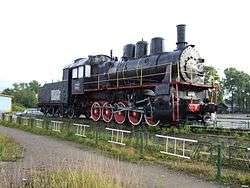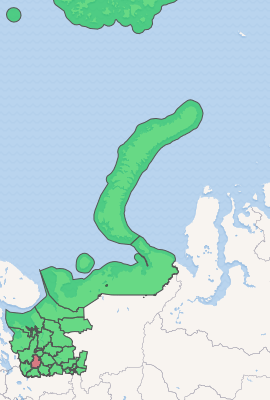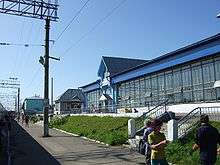Nyandomsky District
Nyandomsky District (Russian: Ня́ндомский райо́н) is an administrative district (raion), one of the twenty-one in Arkhangelsk Oblast, Russia.[1] As a municipal division, it is incorporated as Nyandomsky Municipal District.[7] It is located in the southwest of the oblast and borders with Plesetsky District in the north and west, Shenkursky District in the east, Velsky District in the southeast, Konoshsky District in the south, and with Kargopolsky District in the southwest. The area of the district is 8,100 square kilometers (3,100 sq mi).[4] Its administrative center is the town of Nyandoma.[3] Population: 30,244 (2010 Census);[5] 33,465 (2002 Census);[9] 40,601 (1989 Census).[10] The population of Nyandoma accounts for 73.9% of the district's total population.[5]
Nyandomsky District Няндомский район | |
|---|---|
 Steam locomotive in Nyandoma, Nyandomsky District | |
 Flag  Coat of arms | |

Location of Nyandomsky District in the Arkhangelsk Oblast | |
| Coordinates: 61°40′N 40°12′E | |
| Country | Russia |
| Federal subject | Arkhangelsk Oblast[1] |
| Established | July 15, 1929[2] |
| Administrative center | Nyandoma[3] |
| Area | |
| • Total | 8,100 km2 (3,100 sq mi) |
| Population | |
| • Total | 30,244 |
| • Estimate (2018)[6] | 26,002 (-14%) |
| • Density | 3.7/km2 (9.7/sq mi) |
| • Urban | 73.9% |
| • Rural | 26.1% |
| Administrative structure | |
| • Administrative divisions | 1 Towns of district significance, 8 Selsoviets |
| • Inhabited localities[3] | 1 Cities/towns, 156 Rural localities |
| Municipal structure | |
| • Municipally incorporated as | Nyandomsky Municipal District[7] |
| • Municipal divisions[7] | 1 Urban settlements, 2 Rural settlements |
| Time zone | UTC+3 (MSK |
| OKTMO ID | 11644000 |
| Website | http://www.nyan-doma.ru/ |
History
The area was originally populated by the Finno-Ugric peoples and then colonized by the Novgorod Republic. It was always a remote part of Kargopol lands with sparse population. In the course of the administrative reform carried out in 1708 by Peter the Great, the area was included into Ingermanland Governorate (known from 1710 as Saint Petersburg Governorate). In 1727, it was transferred to the newly established Novgorod Governorate. After a number of administrative reforms, Kargopolsky Uyezd became one of the four uyezds of the newly established Olonets Governorate. In 1894, the decision was taken on the railroad construction from Vologda to Arkhangelsk. It was decided that the railroad would take the shortest route, which means it bypasses Kargopol and traverses the current territory of Nyandomsky District. In 1896, Nyandoma was founded as a railway station.
On July 15, 1929, the uyezds were abolished, the governorates merged into Northern Krai, and Nyandomsky District was established among others. It became a part of Nyandoma Okrug, one of the five in Northern Krai.[2] In 1930, the okrug was abolished, and the district was subordinated to the central administration of Northern Krai. For a short period in the 1930s, the district absorbed some of the areas of abolished Konoshsky District, but in 1935 Konoshsky District was reestablished, and the areas were ceded to it. In 1936, the krai itself was transformed into Northern Oblast. In 1937, Northern Oblast was split into Arkhangelsk Oblast and Vologda Oblast. Nyandomsky District remained in Arkhangelsk Oblast ever since.
Geography
A major part of the district belongs to the basin of the Onega River. The Mosha River, a right tributary of the Onega, has its source in Lake Bolshoye Moshenskoye in the southeast of the district and flows northwest dividing the district into two roughly equal parts. The areas in the west of the district are in the basin of the Voloshka River, also a right tributary of the Onega. Minor areas in the east of the district belong to the basins of the left tributaries of the Vaga River—the Vel, the Padenga, and the Led. An area in the north of the district belongs to the basin of the Mekhrenga River, a right tributary of the Yemtsa. There are many lakes in the district, the biggest one being Lake Nimengskoye, which belongs to the basin of the Voloshka River.
A major part of the district is covered by coniferous forests (taiga). There are many swamps in the area.
Divisions
Administrative divisions
As an administrative division, the district is divided into eight selsoviets and one town of district significance (Nyandoma).[3] One locality which previously had urban-type settlement status (Shalakusha), was downgraded to a rural locality in 2005. The following selsoviets have been established (the administrative centers are given in parentheses):[3]
- Andreyevsky (Andreyevskaya);
- Burachikhinsky (Burachikhinskaya);
- Lepshinsky (Stupinskaya);
- Limsky (Navolok);
- Moshinsky (Makarovskaya);
- Shalakushsky (Shalakusha);
- Shozhemsky (Shestiozersky);
- Voyezersky (Gridino).
Municipal divisions
As a municipal division, the district is divided into one urban settlement and two rural settlements (the administrative centers are given in parentheses):[7]
- Nyandomskoye Urban Settlement (Nyandoma);
- Moshinskoye Rural Settlement (Makarovskaya);
- Shalakushskoye Rural Settlement (Shalakusha).
Economy
Industry
The most important industry in the district is timber industry. Food industry is also present[11]
Agriculture
Agriculture in the region is limited mostly to milk and meat production.[11]
Transportation

Nyandoma is on the paved road connecting Dolmatovo, which is on one of the principal highways in Russia, M8 connecting Moscow and Arkhangelsk, with Kargopol. Another paved road, in the southern direction, connects Nyandoma with Konosha.
Nyandoma is located on the railway line between Moscow and Arkhangelsk (built in the south-north direction), and as a matter of fact was founded in 1896 as a railway station and was only granted town status in 1939.[12]
Culture and recreation
The district contains thirty-one objects classified as cultural and historical heritage of local importance.[13] Most of these are chapels and wooden rural houses built prior to 1917.
The only state museum in the district is the House of Nyan, in Nyandoma.[14]
References
Notes
- Law #65-5-OZ
- "Archived copy" Постановление Президиума ВЦИК от 15 июля 1929 года о составе округов и районов Северного Края и их центрах (in Russian). consultant.ru. Archived from the original on January 4, 2016. Retrieved June 12, 2011.CS1 maint: archived copy as title (link)
- Государственный комитет Российской Федерации по статистике. Комитет Российской Федерации по стандартизации, метрологии и сертификации. №ОК 019-95 1 января 1997 г. «Общероссийский классификатор объектов административно-территориального деления. Код 11 244», в ред. изменения №278/2015 от 1 января 2016 г.. (State Statistics Committee of the Russian Federation. Committee of the Russian Federation on Standardization, Metrology, and Certification. #OK 019-95 January 1, 1997 Russian Classification of Objects of Administrative Division (OKATO). Code 11 244, as amended by the Amendment #278/2015 of January 1, 2016. ).
- Няндомский район (in Russian). Двина-Информ. Retrieved August 4, 2011.
- Russian Federal State Statistics Service (2011). "Всероссийская перепись населения 2010 года. Том 1" [2010 All-Russian Population Census, vol. 1]. Всероссийская перепись населения 2010 года [2010 All-Russia Population Census] (in Russian). Federal State Statistics Service.
- "26. Численность постоянного населения Российской Федерации по муниципальным образованиям на 1 января 2018 года". Federal State Statistics Service. Retrieved January 23, 2019.
- Law #258-vneoch.-OZ
- "Об исчислении времени". Официальный интернет-портал правовой информации (in Russian). June 3, 2011. Retrieved January 19, 2019.
- Russian Federal State Statistics Service (May 21, 2004). "Численность населения России, субъектов Российской Федерации в составе федеральных округов, районов, городских поселений, сельских населённых пунктов – районных центров и сельских населённых пунктов с населением 3 тысячи и более человек" [Population of Russia, Its Federal Districts, Federal Subjects, Districts, Urban Localities, Rural Localities—Administrative Centers, and Rural Localities with Population of Over 3,000] (XLS). Всероссийская перепись населения 2002 года [All-Russia Population Census of 2002] (in Russian).
- "Всесоюзная перепись населения 1989 г. Численность наличного населения союзных и автономных республик, автономных областей и округов, краёв, областей, районов, городских поселений и сёл-райцентров" [All Union Population Census of 1989: Present Population of Union and Autonomous Republics, Autonomous Oblasts and Okrugs, Krais, Oblasts, Districts, Urban Settlements, and Villages Serving as District Administrative Centers]. Всесоюзная перепись населения 1989 года [All-Union Population Census of 1989] (in Russian). Институт демографии Национального исследовательского университета: Высшая школа экономики [Institute of Demography at the National Research University: Higher School of Economics]. 1989 – via Demoscope Weekly.
- Программа развития района (in Russian). Администрация МО «Няндомский муниципальный район». Retrieved June 13, 2011.
- Энциклопедия Города России. Moscow: Большая Российская Энциклопедия. 2003. p. 322. ISBN 5-7107-7399-9.
- Памятники истории и культуры народов Российской Федерации (in Russian). Russian Ministry of Culture. Retrieved June 2, 2016.
- Няндомский музей "Дом Няна" (in Russian). Российская сеть культурного наследия. Retrieved June 13, 2011.
Sources
- Архангельское областное Собрание депутатов. Областной закон №65-5-ОЗ от 23 сентября 2009 г. «Об административно-территориальном устройстве Архангельской области», в ред. Областного закона №232-13-ОЗ от 16 декабря 2014 г. «О внесении изменений в отдельные Областные Законы в сфере осуществления местного самоуправления и взаимодействия с некоммерческими организациями». Вступил в силу через десять дней со дня официального опубликования. Опубликован: "Волна", №43, 6 октября 2009 г. (Arkhangelsk Oblast Council of Deputies. Oblast Law #65-5-OZ of September 23, 2009 On the Administrative-Territorial Structure of Arkhangelsk Oblast, as amended by the Oblast Law #232-13-OZ of December 16, 2014 On Amending Various Oblast Laws Dealing with the Process of Municipal Self-Government and Relations with Non-Profit Organizations. Effective as of the day which is ten days after the official publication.).
- Архангельское областное Собрание депутатов. Областной закон №258-внеоч.-ОЗ от 23 сентября 2004 г. «О статусе и границах территорий муниципальных образований в Архангельской области», в ред. Областного закона №224-13-ОЗ от 16 декабря 2014 г. «Об упразднении отдельных населённых пунктов Соловецкого района Архангельской области и о внесении изменения в статью 46 Областного закона "О статусе и границах территорий муниципальных образований в Архангельской области"». Вступил в силу со дня официального опубликования. Опубликован: "Волна", №38, 8 октября 2004 г. (Arkhangelsk Oblast Council of Deputies. Oblast Law #258-vneoch.-OZ of September 23, 2004 On the Status and Borders of the Territories of the Municipal Formations in Arkhangelsk Oblast, as amended by the Oblast Law #224-13-OZ of December 16, 2014 On Abolishing Several Inhabited Localities in Solovetsky District of Arkhangelsk Oblast and on Amending Article 46 of the Oblast Law "On the Status and Borders of the Territories of the Municipal Formations in Arkhangelsk Oblast". Effective as of the day of the official publication.).
.png)